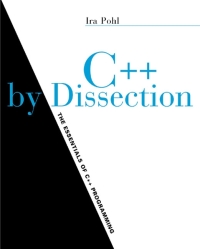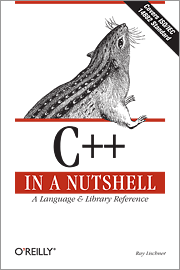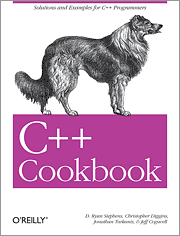
| Course | Days | Times | Location | ||
| CIS 15 | MW | 2.15 pm | - | 3.55 pm | 238 New Ingersoll |
The first is the only real textbook I'm going to list. It's the one that I used the most in constructing the course. It's a pretty good book for those new to C++ and object-oriented programming. The only flaw as far as this course is concerned is that it starts by assuming you know nothing about programming in C++ (whereas you should have already have studied the basics of the language).

| |
| C++ By Dissection by Ira Pohl, Addison Wesley, 2001 (ISBN-10: 0201787334, ISBN-13: 978-0201787337) | |
| This should be available from the college bookstore. |
The second book is not a book that you should buy to teach you about C++ , but it is a very comprehesive reference, a book to go back to again and again while you are programming in C++. Then again, you can find a lot of this information online.

| |
| C++ in a Nutshell: A Language & Library Reference by Ray Lischner, O'Reilly, 2003, (ISBN-13: 978-0-596-00298-5) | |
| You can get this from Amazon or direct from the publisher's website. |
The last book listed is not a textbook or a reference, but a series of examples of things you are likely to need to do (like building applications, handling strings, dealing with dates and times, generating random numbers), that provide "a treasure trove of solutions to everyday C++ programming problems".

| |
| C++ Cookbook by D Ryan Stephens, Christopher Diggins, Jonathan Turkanis & Jeff Cogswell, O'Reilly, 2005, (ISBN-13: 978-0-596-00761-4) | |
| You can get this from Amazon or direct from the publisher's website. |
We will cover Unix fundamentals, classes, specification and testing, pointers and arrays, object-oriented programming, recursion and templates.
The exercises in the course feature simple versions of a number of common applications, including simulation, crytography, graphics and robotics.
You can find more detail on what we will cover on the syllabus page.
Finally, here are some hints for how to succeed in CIS 1.5.